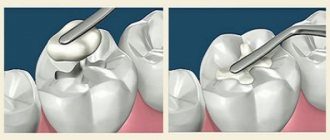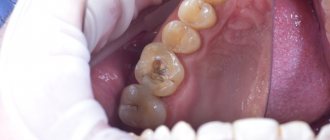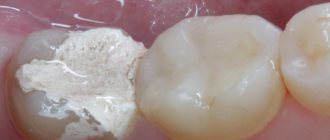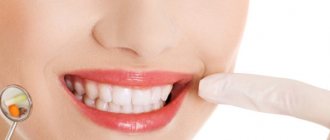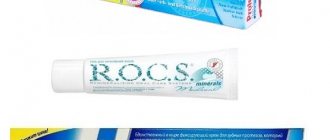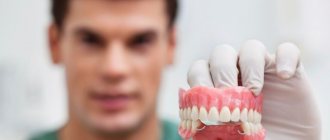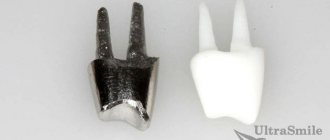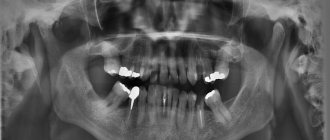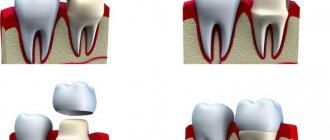From this article you will learn:
- what is tooth root cement,
- its structure and functions,
- histological preparations.
Dental cement (cementum) is a highly mineralized tissue, reminiscent in its structure of coarse-fiber bone, which covers the root of the tooth (up to its neck) with a thin layer. But unlike bone tissue, root cement is not subject to constant restructuring, it does not have vessels, and its trophism is carried out through the usual diffusion of nutrients dissolved in the main amorphous substance in the periodontal structure.
The main function of cement is to form the ligamentous apparatus of the tooth (periodontal attachment), which holds the tooth in the alveolus, and also contributes to the redistribution of chewing pressure from the tooth to the alveolar bone. Let us recall that periodontal fibers begin to grow simultaneously - both from the side of the root cement and from the side of the compact lamina of the alveoli. Next, with the help of immature collagen (procollagen) in the center of the periodontal fissure, the ends of these fibers are tied together, bundles of fibers are formed.
Tooth root cement: diagram and photo
The cementum layer is present only on human teeth, as well as on the teeth of other mammals. In the area of the tooth neck, the thickness of the cement is less - from 20 to 50 microns, while in the area of the root apex - from 100 to 150 microns. I think you are familiar with the fact that “secondary dentin” is produced by odontoblasts throughout life, and in the same way, constant formation of cement on the root surface occurs throughout life. And therefore, if you live to retirement age, the cement of your teeth will most likely have time to at least triple its thickness (Fig. 3).
Cement for dental crowns
Causes of crown loss
What to do if a dental crown falls out
Cement for dental crowns
Features of various cements for crowns
Prevention of crown loss
To restore a badly damaged tooth, a crown is needed. This is an orthopedic structure in the form of a cap, which is attached to the tooth using special cement. It protects the tooth from damage and maintains its functionality. However, due to improper hygiene or unprofessionalism of the doctor, the crown may fall off. What to do if a dental crown falls out? Can I attach it myself? Or is it better to seek help from a doctor?
Structure
The structure of primary and secondary cements is different.
- Primary (acellular) consists mainly of collagen fibers, as well as an amorphous adhesive substance.
- The secondary (cellular) structure is similar to coarse-fiber bone, only without blood vessels, and contains mainly cementocytes, cementoblasts and intercellular substance.
Unlike real bone tissue, cement is nourished diffusely through the periodontium. The chemical composition consists of organic substances, which make up 32%, and inorganic substances, which make up 68%.
Causes of crown loss
Several factors can provoke an unpleasant situation associated with dental crowns. They depend both on the actions of the doctor and on the actions of the patient.
- Low quality materials and cement.
- Violation of the manufacturing technique of an orthopedic structure.
- Mistakes at the stage of preparation for prosthetics.
- Development of the inflammatory process under the crown.
- End of service life of the structure.
- Mechanical injury.
The permanent crown is fixed with dental cement and lasts for several years. If the doctor did everything correctly at the preparation stage, then the structure retains its tightness and strength for a long time, and it should not fall out. This can happen due to the development of caries, which appears due to irregular or improper oral hygiene. Therefore, it is so important not to skip brushing your teeth and use additional hygiene products. And also undergo professional oral hygiene at a dental clinic once every six months.
Types of materials used
Today there are a lot of materials, so dentists offer clients a large selection. If we talk about inexpensive options, then these are plastic, cements, amalgam. Ceramics, glass ionomers, and polymers will be more expensive and of better quality.
Metal
Amalgam contains several metals and mercury. Silver provides the filling with hardness and resistance to corrosion, copper makes the filling strong, thanks to tin the material quickly hardens, and zinc makes it less brittle, does not oxidize and has good ductility.
But if the technology for preparing the substance is violated, a person can be poisoned by mercury. In addition, corrosion can ruin the appearance of your teeth.
Plastic
Such fillings are cheap, but are not very popular. They are very toxic and are not resistant to external factors. In addition, a secondary carious process may develop under such filling material.
Ceramics
This material is expensive, and the production of the lining takes quite a lot of time. But wealthy people often use this type of filling, because such fillings resemble natural enamel. Ceramics are highly durable, resistant to temperature changes, and do not react with the tooth or stain it.
Cement
This type of filling is more often used in the treatment of children. The cement mass is easy to remove, quickly installed, quite lightweight, reduces the risk of caries appearing a second time, and has an anti-caries effect. But cement is toxic and brittle, so additional padding under it is necessary.
Light polymer fillings
This option is the most popular. Glass polymer is affordable, it hardens quickly thanks to an ultraviolet lamp.
It is quite durable, so this filling can last for a long time.
Glass ionomer fillings
It contains fluoride, which prevents caries from developing. In addition, this material is an excellent option for filling baby teeth. It acts as an insulating pad or base.
What to do if a tooth crown falls out
- First of all, you need to save the fallen structure and try to make an appointment with the dentist as soon as possible. For example, contact our specialists by phone: 220-86-30.
- Remember that the tooth that was under the crown was left without protection, so it must be treated as carefully as possible. It is necessary to chew food on the opposite side, trying to minimize the load on the tooth to avoid fracture.
- If pain occurs, take a pain reliever.
- If it is not possible to see a doctor in the near future, then try to carefully put the structure in place; before doing this, it must be thoroughly rinsed and dried. This will help preserve the prepared tooth until your visit to the dentist.
The next method is temporary!
an orthopedic dentist within three days
- Buy dental cement (sold at the pharmacy).
- Clean the crown thoroughly with toothpaste. Dry it with a sterile piece of cloth.
- Clean the tooth from food debris using a soft-bristled toothbrush.
- Apply cement to the crown, place the crown on the tooth and hold it in place for one minute. Then close both jaws and remain in this position for about two minutes.
- Remove any remaining cement using gauze.
Never try to glue a crown with superglue. The glue is very toxic, and contact with saliva can lead to dire consequences!
How are cementum, tooth sensitivity and periodontitis related?
Loss of cementum contributes to a number of dental problems, such as tooth sensitivity, loss of enamel, and gum recession . When cementum is lost, the dentin underneath is exposed, and this, in turn, can cause tooth sensitivity. The latter manifests itself as short-term or acute pain in the area of one or more teeth. If you've ever winced and winced painfully after taking a sip of cold water or juice, you know the feeling!
While cementum loss can trigger the development of some dental diseases, other dental diseases can trigger cementum loss. Such diseases include, for example, periodontitis. Cementum loss occurs when there is irreversible damage to the bone and connective tissue fibers that hold the tooth in place. Such damage to bone tissue and cement is characteristic of progressive periodontitis and leads to tooth mobility, which in some cases even has to be removed.
Cement for dental crowns
Now let's talk about what dental cement is, with which the doctor fixes the crown on the tooth. Few people know, but it comes in different types. The dentist always decides which option is right for you, based on clinical indications.
There are five types of dental cement:
- composites;
- zinc phosphates;
- glass ionomers;
- polycarboxylates;
- polymer modified glass ionomers.
They all have their advantages and disadvantages, so it would be incorrect to say which one is the best.
When choosing a particular type of cement for fixing a crown, the doctor looks at the following indicators.
- Strength is the ability of cement, after hardening, to compress and unclench when teeth are closed during chewing.
- Adhesiveness is the ability of a substance to adhere to tooth tissue.
- Irritability – the likelihood of an allergic reaction.
- How difficult it will be to remove it.
- Aesthetics.
Stages of installing a filling on a tooth
This process is difficult and quite lengthy. The following stages are distinguished:
- anesthetic injection;
- specialists drill out the affected area, remove dentin and enamel that has darkened;
- disinfect the cavity using antiseptic solutions. In case of inflammation of the pulp, it is initially removed;
- dry the cavity;
- place an antimicrobial pad, if necessary, and put an insulating pad on top;
- filling material is placed and adjusted to the shape of the tooth;
- grind and polish the tooth.
Features of various cements for crowns
Table 1. Features of various cements for crowns
| Type of cement | Example | Characteristics | Application |
| Composite cement | High strength and adhesiveness, aesthetics. | Suitable for fixing not only ceramic crowns, but also veneers and lumineers. | |
| Zinc phosphate cement | One of the very first cements used. Easy to use. Has average strength and adhesiveness. May temporarily increase tooth sensitivity (up to 3 weeks). | Suitable for single crowns and small bridges. | |
| Glass ionomer cement | This aluminosilicate glass with a high fluorine content is an excellent caries prevention. High adhesion, but low strength. | It is used for increased risk of caries and high tooth sensitivity. | |
| Polycarboxylate cement | High biocompatibility, serves as additional prevention of caries. However, it has low adhesiveness and strength. | Used for fixing single crowns with high tooth sensitivity. | |
| Modified glass ionomer cement | Innovative material. Combines the advantages of composites and glass ionomers: high strength and adhesiveness. | It is used for installing both single crowns and bridges. Suitable for people with an increased tendency to caries. |
Prevention of crown loss
Once you have a crown installed, we recommend making sure it lasts a long time. To do this, you need to remember and follow simple rules.
- Forget about sticky candies, chewing gum, the habit of biting your nails, the tip of a pencil or pen.
- Brush your teeth regularly. If you haven't used brushes or an irrigator yet, now is the time. Also, don't forget about mouthwash.
- Monitor the condition of the crown. If even small defects are detected, it is recommended to consult a doctor.
- Once every six months, come for a check-up with an orthopedic dentist and do professional oral hygiene.
The loss of a crown causes great inconvenience. If this happens, you should immediately contact your dentist.
Completion of prosthetics
All restorations are veneered according to the same scheme as for demonstration crowns. In the partially fired state, several preliminary fittings of the restorations were carried out, followed by corrections of their structure, until we were able to achieve a result that satisfied all interested parties. The final correction of the occlusion was also carried out during preliminary fitting, so that after glaze firing and final fixation of the crowns, no further mechanical processing was required.
As a result, we produced permanent restorations with a total length of 28 units. Forming a ceramic shoulder, individual veneering, creating an individual surface texture and finishing correction before glaze firing takes a lot of time, but the end result is completely worth all our efforts.
Soft tissue augmentation was performed in the area of tooth 22 to stabilize the weakened gums and prevent further gum recession.
